The Way of Horse and Bow: The Core of Samurai Identity
By Paul 'Batman' O'Brien
B.A., N.C.E.H.S., Dip. Acu., Adv. Dip. OBB, Cert Clin. Med. Pn1, PN-SSR, PN-NCA, M.AFPA, M.ETCMA, M.C.Th.A.
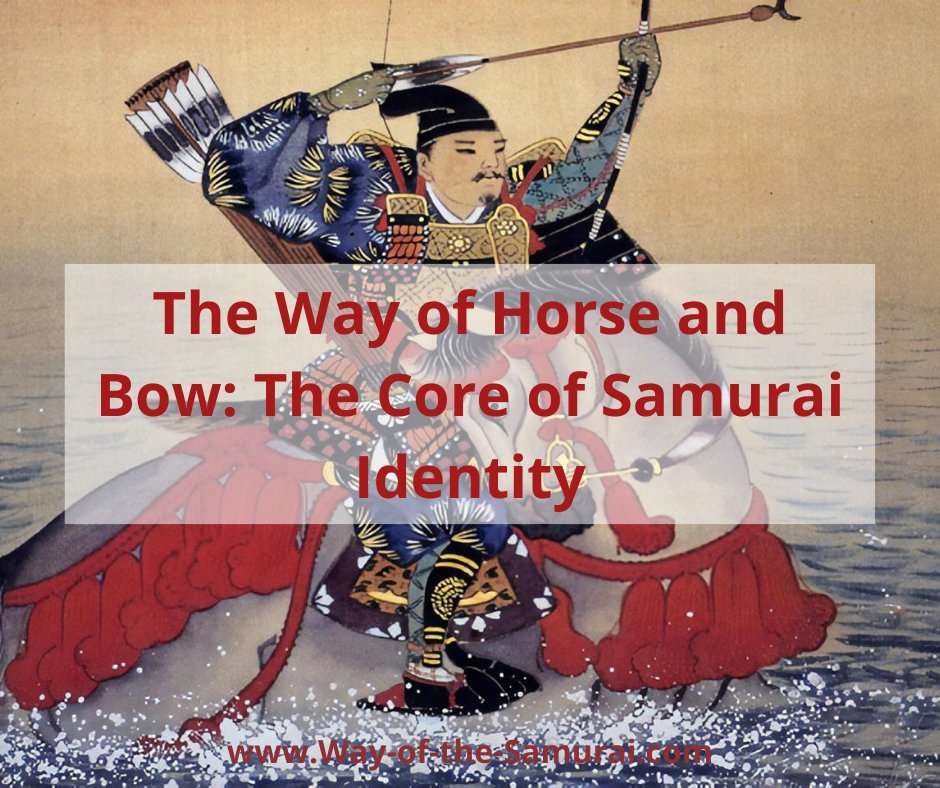
Contrary to modern media, it is The Way of Horse and Bow, not the sword, that is central of the heart of the early samurai's identity. This distinctive fighting style, defined the samurai and their role and shaped their culture for centuries, was mounted archery, known in Japanese as kyūba no michi - "The Way of Horse and Bow". While popular culture often portrays samurai primarily as swordsmen, historical evidence reveals that from the 10th through the 14th centuries, the bow reigned supreme on Japanese battlefields.
Historian Thomas Conlan notes that:
“archery was the mainstay of battle, as most fought primarily with projectiles rather than attempting to engage in hand-to-hand combat”
- Conlan, T. (2020). The Rise of Warriors During the Warring States Period. Japan: Past and Present, Published by the Axel and Margarate Ax:Son Johnson Foundation. (Stockholm),
Arrows, not swords, felled most warriors during the Kamakura period. Battle accounts and reward petitions from this era consistently show arrows as the primary cause of casualties. This reality contrasts sharply with later romantic depictions that emphasised swordsmanship.
To understand why mounted archery became so central to samurai identity, we must consider both the practical and cultural factors that elevated this fighting style above all others. When Japan's imperial court began relying on professional warriors rather than conscript armies, it needed fighters who could respond quickly to bandits, rebels, and other threats to public order. Mounted archers proved ideal for this purpose. Their mobility allowed them to cover large distances rapidly, while their missile weapons gave them the ability to engage enemies from a distance.
Mobility Over Mass
As Karl Friday explains in his research on early medieval warfare,
“The mobility of cavalry, both on and off the battlefield, makes it the natural arm of attack and pursuit—an important consideration for Heian warriors, whose functions centered on law-enforcement rather than border defense”
- Friday, K.F. (2004). Samurai, Warfare and the State in Early Medieval Japan (1st ed.). Routledge
The early samurai rode distinctive Japanese horses that were smaller than their modern counterparts. Archaeological evidence from the Kamakura period (1185-1333) shows that these war horses typically stood between 126 and 136 centimetres at the shoulder - more like heavy ponies than the large chargers depicted in later artwork. Though lacking the size and speed of modern horses, these mounts were prized for their endurance and surefootedness in Japan's mountainous terrain.
And they’ve tested this. Dr. Friday notes in his text, “Samurai, Warfare and the State in Early Medieval Japan”, that the NHK (The Japan Broadcasting Corporation) aired an excellent demonstration of comparing modern thoroughbreds to the war horses of the Heian Warriors.
“A pony standing 130 cm tall and weighing 350 kilograms – larger than average for early medieval horses – was timed while carrying a 50 kilogram rider and bags of sand totaling 45 kilograms (to simulate the weight of armor and weapons). The poor beast dropped from a gallop to a trot almost immediately, and never exceeded 9 kilometers per hour. After running for ten minutes, the horse was visibly exhausted. To put these numbers in perspective: unladen thoroughbreds can gallop at up to 60 kilometers per hour, while the standard prescribed during the Meiji period for cavalry mounts carrying (unarmored) riders was 300 meters per minute – about 18 kilometers per hour”
- Friday, K.F. (2004). Samurai, Warfare and the State in Early Medieval Japan (1st ed.). Routledge
Weapon of The Way of Horse and Bow
The Japanese bow (yumi) used by these mounted warriors was, like the steeds, equally distinctive. Unlike the short composite bows favoured by steppe nomads like the Mongols, the Japanese developed an asymmetric longbow that could be up to 2.5 meters in length. This unusual design, with the grip positioned about one-third of the way from the bottom rather than in the middle, allowed mounted archers to use these lengthy weapons effectively from horseback.
The physical demands of this fighting style are deeply impressive. Maintaining a gallop while drawing and shooting accurately requires extraordinary strength, balance, and coordination - skills that could only be developed through years of dedicated training.
This intensive training began in childhood for many samurai sons. Young boys started with small bows appropriate to their size and strength, gradually working up to full-sized weapons as they matured. They learned not only how to shoot accurately but also how to control their mounts using only their legs and weight shifts, leaving both hands free to manage the bow. The complexity of these skills meant that mounted archery became a marker of elite status - something that set samurai apart from ordinary soldiers.
Peerless in the Way
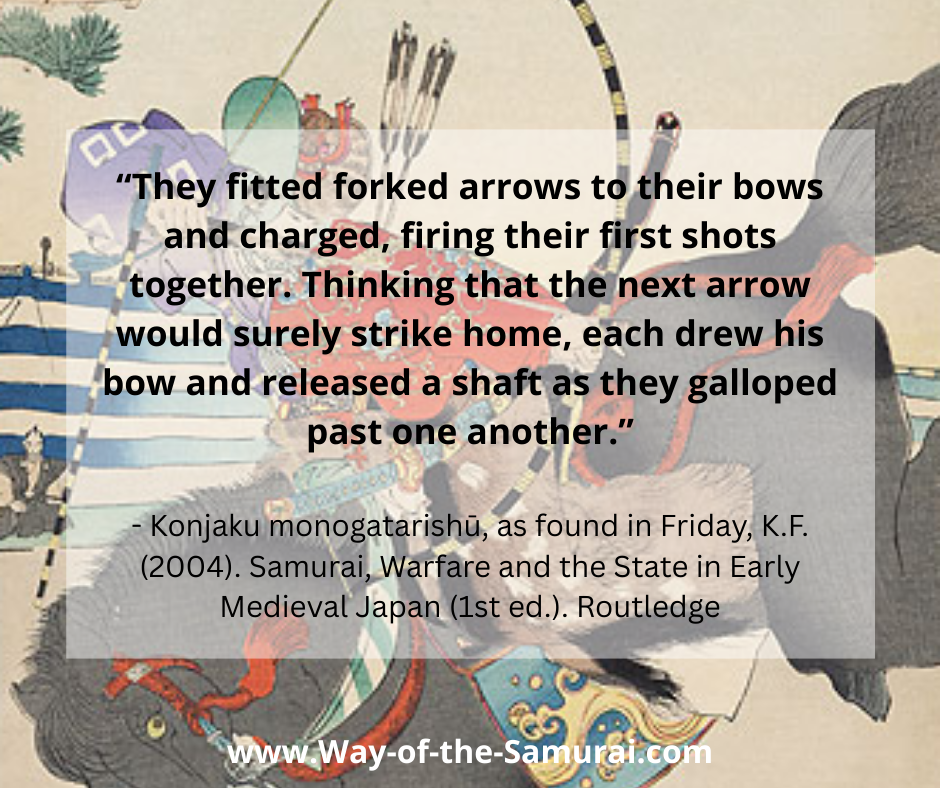
Consider the career of Minamoto no Yoriyoshi, a famous 11th-century warrior. A warrior of legendary skill and peerless in the way of horse and bow. His skill with these weapons made him the natural choice to lead campaigns against rebels in northern Japan. When the court needed to restore order in distant provinces, they turned to men like Yoriyoshi precisely because they excelled at mounted combat.
The techniques used by these early samurai were quite different from the disciplined volley fire associated with later infantry armies. In battle, samurai archers typically engaged in what modern observers might call "dogfighting"—individual warriors or small teams maneuvering to gain advantageous positions from which to shoot at opponents. Since Japanese bows of this period had limited range and power, warriors had to close to very short distances - sometimes only 10 meters - to penetrate an enemy's armor.
A vivid description from the Konjaku monogatarishū collection illustrates this style of combat:
“They fitted forked arrows to their bows and charged, firing their first shots together. Thinking that the next arrow would surely strike home, each drew his bow and released a shaft as they galloped past one another. They pulled up their horses and returned for another pass, again drawing bow but this time releasing no arrows as they rode by. Again they reined in their horses and turned. Again they drew their bows and aimed. Yoshifumi shot at Mitsuru s midsection, but, moving as if falling from his mount, Mitsuru dodged the arrow, which struck the scabbard of his long sword. He then once again turned his horse and took aim at Yoshifumi’s midsection. But Yoshifumi twisted his body, so that the arrow only struck his sword belt. Once more quickly reining in and turning their horses, they again notched arrows and charged”
- Friday, K.F. (2004). Samurai, Warfare and the State in Early Medieval Japan (1st ed.). Routledge
Armour and Identity

The specialised armour worn by early samurai reflected the primacy of mounted archery. The distinctive ō-yoroi armour, with its box-like shape and large rectangular shoulder plates (ō-sode), was specifically designed for horse-borne archers. It featured:
- A box-like (ō-yoroi) construction that protected the torso while allowing freedom to shoot
- Large rectangular shoulder guards (sode) that provided additional protection when the archer's arms were raised
- A distinctive helmet (kabuto) with a prominent neck guard
- A face mask (menpo) that protected the lower face while leaving visibility unimpaired
The shoulder plates could swing back out of the way when the warrior drew his bow, but would fall forward to protect his upper body between shots. The armour's loose fit allowed it to hang over the saddle, protecting the rider's thighs, while its layered construction absorbed the impact of enemy arrows.
This armour was not only functional but also a marker of identity. Distinctive lacings, colours, and crests (mon) helped identify warriors on the battlefield – crucial for both allies and enemies to recognise who had scored kills or performed valorously. The armour's decoration became increasingly elaborate over time, particularly among high-ranking samurai who could afford ornate designs.
Exorcisms in the Way of Horse and Bow
Beyond its practical applications, mounted archery also took on important ritual and spiritual dimensions in samurai culture. Archery was seen as a purifying practice with connections to Shintō beliefs. The Takiguchi guardsmen of the imperial palace seemed to exclusively perform ceremonial archery (meigen meaning “sighing bowstring” or tsuru-uchi meaning “striking the bowstring”) to ward off evil spirits. Drawing and releasing the bow without an arrow was believed to have exorcistic power, showing how deeply intertwined martial skills were with spiritual practices.
The Kamakura shogunate further institutionalised mounted archery as the defining practice of the warrior class. Minamoto no Yoritomo, the first shogun, organised hunting expeditions and archery contests known as Yabusame (流鏑馬) that served both as training exercises and as opportunities to reinforce the social bonds among his vassals. Success in these events brought recognition and rewards, cementing the importance of kyūba no michi, the Way of Horse and Bow, in samurai identity.
A telling example comes from the 1180s, when, during a deer hunt, Yoritomo’s horse stumbled while pursuing prey through dense forest. Rather than falling, Yoritomo maintained his seat and managed to shoot the deer despite the disruption. Observers noted that this same balance and focus would serve him well in combat, where battlefield conditions created similar challenges for mounted archers.
Yoritomo went on to organise deer hunts at the foot of Mount Fuji. His vassals competed to demonstrate their mounted archery skills, and those who excelled received promotions and lands. These events were not merely recreational—they were formal demonstrations of the martial abilities that qualified men for military service and political authority.
Even as warfare evolved over subsequent centuries, the cultural prestige of mounted archery remained strong. When the Mongols attempted to invade Japan in 1274 and 1281, Japanese warriors faced enemy tactics very different from their own individual-focused style. Yet despite the challenges posed by these encounters, samurai continued to identify themselves primarily as mounted archers until well into the 14th century.
Kyūba no michi in Modern Times
For modern practitioners of Japanese martial arts, the legacy of kyūba no michi lives on most directly in kyūdō - Japanese archery. While today's kyūdō is typically practised on foot rather than horseback, it preserves many elements of the ancient tradition, including the distinctive asymmetric bow and the emphasis on proper form and spiritual development. The careful attention to stance, breathing, and mental focus in kyūdō derives from centuries of refinement in the way of horse and bow.
The art of mounted archery, yabusame (流鏑馬), also still continues to this day. Today, it retains strong ritual significance, with elaborate ceremonial dress, religious purification rites, and processions accompanying the actual mounted archery display.
Several schools of archery preserve and transmit Yabusame traditions, the most prominent being the Ōgasawara-ryū, a lineage of etiquette (which we practice within the schools of Iai and Kenutsu I study), horsemanship, and archery that has been closely tied to court ritual since the Kamakura era. The Takeda-ryū and Kasuga-ryū also maintain styles of mounted archery, with variations in form and ritual. Training in Yabusame requires mastery not only of kyūdō (Japanese archery) but also of horsemanship, posture, breath control, and the ritual etiquette (reihō) that accompanies the performance.
Modern Yabusame is practiced primarily as a ceremonial art rather than a battlefield skill, with demonstrations held at shrines such as Tsurugaoka Hachimangū in Kamakura, Shimogamo Shrine in Kyoto, and Nikko Toshogu Shrine in Tochigi. These events attract large audiences and are seen as living links to Japan’s samurai heritage. You can watch a modern example below:
Legacy of The Way of Horse and Bow
Other martial arts also bear the influence of this tradition. The disciplined practice, the relationship between technical precision and spiritual development, and the emphasis on personal mastery are all elements that can be traced back to the mounted archery tradition of the early samurai.
The way of horse and bow shaped not only how samurai fought but how they understood their place in the world. By appreciating this foundation, we gain deeper insight into the martial traditions that continue to inspire and challenge us today.
As you train in Japanese martial arts today, remember that you are connecting with a tradition that began with warriors on horseback, bow in hand, riding forth to maintain order and defend their lords. Their legacy reminds us that true mastery comes not just from learning techniques, but from integrating those techniques into a comprehensive way of life - a path of discipline, service, and continual self-improvement.
If you'd like to train in authentic Japanese Martial Arts, those same warrior skills developed by the samurai, check out my dojo at DublinKendo.com
- - - -
If you want to get in great physical, mental and emotional shape using the same principles and techniques inspired by the feudal warriors and healers of Japan, check out my Samurai Strength Programs.
Click here to return to the Way of the Samurai Home Page.
Free Samurai E-books
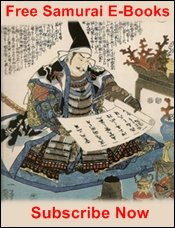
Get Free Exclusive Samurai Guides and E-books

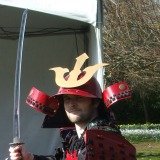
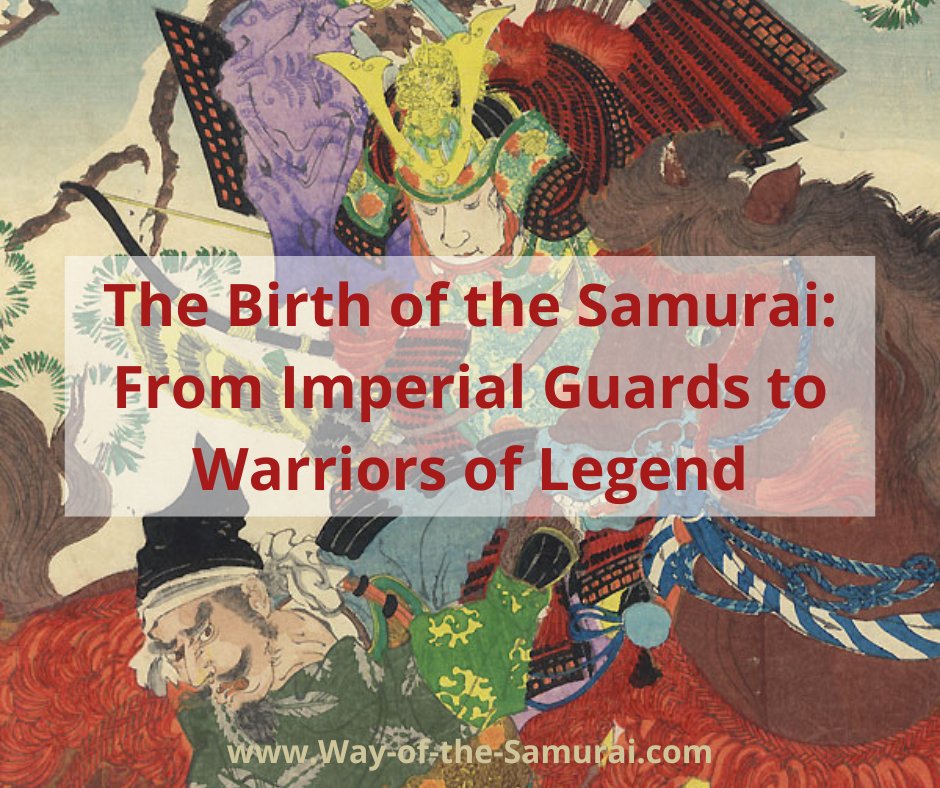




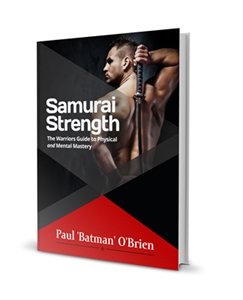
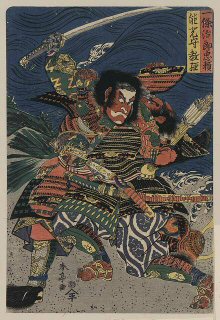
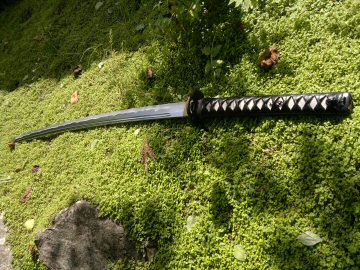
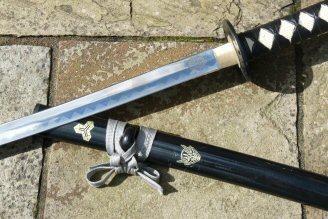
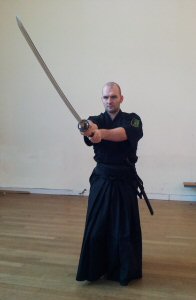
New! Comments
Have your say about what you just read! Leave me a comment in the box below.